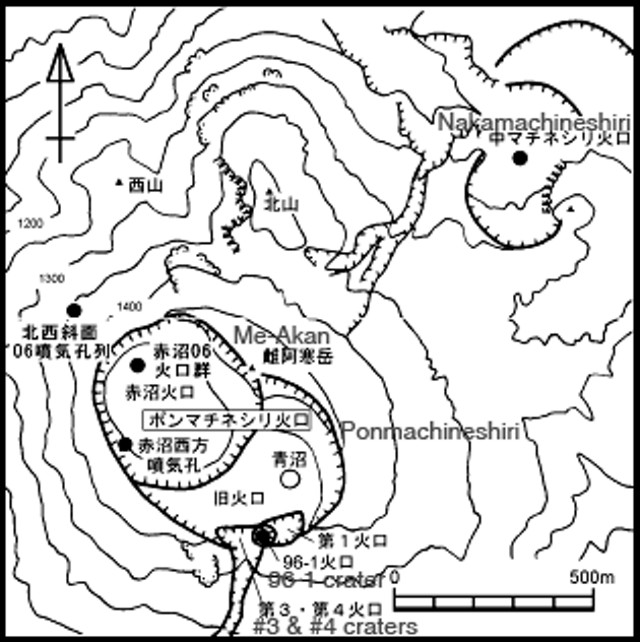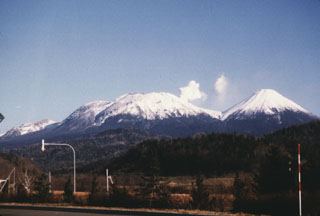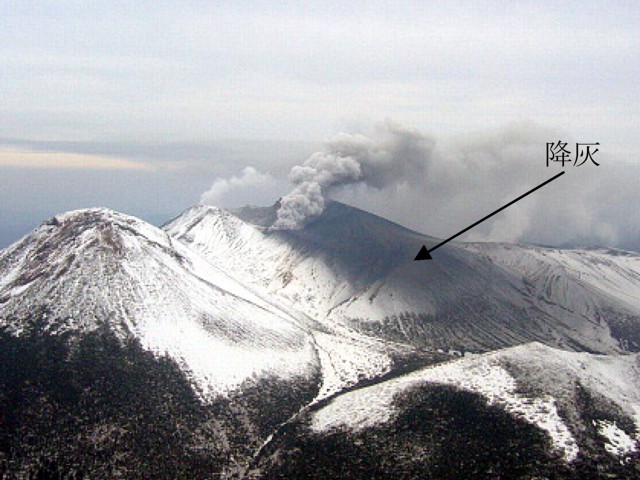Report on Akan (Japan) — October 2008
Bulletin of the Global Volcanism Network, vol. 33, no. 10 (October 2008)
Managing Editor: Richard Wunderman.
Akan (Japan) Small eruptions on 18 and 28 November cause ashfall on the snow surface
Please cite this report as:
Global Volcanism Program, 2008. Report on Akan (Japan) (Wunderman, R., ed.). Bulletin of the Global Volcanism Network, 33:10. Smithsonian Institution. https://doi.org/10.5479/si.GVP.BGVN200810-285070
Akan
Japan
43.384°N, 144.013°E; summit elev. 1499 m
All times are local (unless otherwise noted)
A minor eruption on 21 March 2006 produced minor ashfall around the summit (BGVN 31:02). This report begins with activity seen at the Akan volcanic complex (figure 8) on 29 September 2008, which included a four-minute seismic tremor at Me-Akan, prompting the Japan Meteorological Agency (JMA) to raise the Alert Level to a "near-crater warning." The number of earthquakes had increased since 26 September. A white plume rose less than 100 m above the Me-Akan volcano group, which is part of the Akan volcanic complex.
 |
Figure 8. A map of Akan with translations for some of the critical features of interest. Courtesy of JMA. |
On 17 October, JMA lowered the Alert Level to normal. Seismic tremor was no longer detected after 30 September, and seismicity had remained low after 3 October. On 17 November, JMA again raised the Alert Level to "near-crater warning" after the seismic network detected tremor that lasted 171 minutes.
On 18 November the summit was obscured by cloud cover, but web camera views showed that the snow-covered S slopes had turned black. During an overflight later that day, JMA scientists noted that the ash covered an area up to 400 m away from Ponmachineshiri crater on Me-Akan volcano. Ballistic lithics several tens of centimeters in diameter were deposited around the crater.
On 28 November Me-Akan erupted again (figures 9 and 10). An ash plume rose to an altitude of 2 km and drifted N, E, and SE. According to JMA, ash was deposited on the E flank up to 4 km away from the crater, and the black ash cover on snow surface appeared wider and thicker than on 18 November.
 |
Figure 10. A view of Me-Akan from the S taken at at 1151 on 28 November showing views of steam emissions from both the "96-1 crater" (crater ##1 of 1996) and the number 4 crater. Courtesy of JMA. |
Geological Summary. Akan is a 13 x 24 km caldera located immediately SW of Kussharo caldera in eastern Hokkaido. The elongated, irregular outline of the caldera rim reflects its incremental formation during major explosive eruptions from the early to mid-Pleistocene. There are four post-caldera stratovolcanoes, three at the SW end of the caldera and the other on the NE side. Conical Oakandake was frequently active during the Holocene. The 1-km-wide Nakamachineshiri crater of Meakandake was formed during a major pumice-and-scoria eruption about 13,500 years ago. The Meakandake group, composed of nine overlapping cones E of Lake Akan, has produced mild phreatic eruptions since the beginning of the 19th century. The main cone of Meakandake proper has a triple crater at its summit. Although recorded eruptions at Meakandake have consisted of minor phreatic explosions, four major magmatic eruptions with pyroclastic flows have also occurred during the Holocene.
Information Contacts: Volcanological Division, Seismological and Volcanological Department, Japan Meteorological Agency (JMA), 1-3-4 Ote-machi, Chiyoda-ku, Tokyo 100, Japan (URL: http://www.jma.go.jp/).


